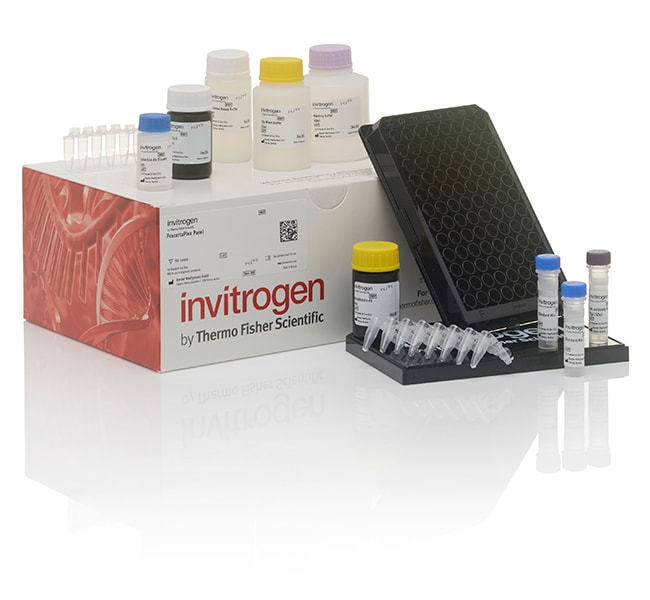Search

ProcartaPlex™ Mouse Cytokine & Chemokine Panel 1A, 36plex
| Número do catálogo | Quantity |
|---|---|
| EPX360-26092-901 | 96 Tests |
The ProcartaPlex Mouse Cytokine & Chemokine Panel 1A 36plex enables the study of immune function by analyzing 36 protein targets in a single well using Luminex xMAP technology. The panel is comprised of four modular sub-panels that allow for an initial broad screen to determine targets of interest and subsequent studies analyzing specific functional subsets of cytokines that can be purchased separately. The sub-panels are fully combinable with each other or with individual simplex assays corresponding to the targets in the panel. The same targets can be found in the Mouse Cytokine & Chemokine Convenience Panel 1A 36plex (Cat. No. EPXR360-26092-901) that is in a ready-to-use format that requires less pipetting.
ProcartaPlex preconfigured panels are extensively tested for analyte combinability, interference, and cross-reactivity to provide the highest level of validation and precision. All ProcartaPlex panels are supplied with the necessary reagents to perform the assay.
ProcartaPlex multiplex panels are available in multiple formats across six species (human, mouse, rat, nonhuman primate, porcine, and canine). Visit our ProcartaPlex Immunoassays page for more information and available products.
Target list [bead region]:
Th1/Th2: GM-CSF [42], IFN gamma [38], IL-1 beta [19], IL-2 [20], IL-4 [26], IL-5 [27], IL-6 [28], IL-12p70 [39], IL-13 [35], IL-18 [66], TNF alpha [45]
Th9/Th17/Th22/Treg: IL-9 [34], IL-10 [13], IL-17A (CTLA-8) [52], IL-22 [33], IL-23 [37], IL-27 [36]
Inflammatory cytokines: G-CSF (CSF-3) [12], IFN alpha [30], IL-3 [14], IL-15/IL-15R [54], IL-28 [64], IL-31 [76], IL-1 alpha [56], LIF [18], ENA-78 (CXCL5) [57], M-CSF [21]
Chemokines: Eotaxin (CCL11) [62], GRO alpha (CXCL1) [43], IP-10 (CXCL10) [22], MCP-1 (CCL2) [51], MCP-3 (CCL7) [48], MIP-1 alpha (CCL3) [47], MIP-1 beta (CCL4) [72], MIP-2 [55], RANTES (CCL5) [44]
About ProcartaPlex assays for the Luminex platform
ProcartaPlex immunoassays are based on the principles of a sandwich ELISA, using two highly specific antibodies binding to different epitopes of one protein to quantitate all protein targets simultaneously using a Luminex instrument. ProcartaPlex multiplex assays require as little as 25 μL of plasma or serum, or 50 μL of cell culture supernatant, and just four hours to obtain analyzed results.
Features include:
• Reproducible, reliable results—validated as a panel to the highest industry standard, including protein target combinability and cross-reactivity testing
• More results per sample—measure multiple protein targets simultaneously in a single 25–50 μL sample
• Well-established Luminex technology highly referenced multiplexing platform for protein detection and quantitation
ProcartaPlex assays utilize Luminex xMAP (multianalyte profiling) technology for the simultaneous detection and quantitation of up to 80 protein targets in a single 25–50 μL sample—from plasma, serum, cell culture supernatants, and other bodily fluids.
The Luminex beads in the ProcartaPlex assay are internally dyed with precise proportions of red and infrared fluorophores to create spectrally unique signatures that can be identified by the Luminex xMAP detection systems (e.g., Luminex 200, FLEXMAP 3D, and MAGPIX). Similar to a sandwich ELISA, the ProcartaPlex assay uses matched antibody pairs to identify the protein of interest. In a multiplexed assay, each spectrally unique bead is labeled with antibodies specific for a single target protein, and bound proteins are identified with biotinylated antibodies and streptavidin–R-phycoerythrin (RPE). The conjugation of protein-specific antibodies to a distinct bead allows for analysis of multiple targets in a single well.
The most significant difference between a ProcartaPlex assay and ELISA is that the capture antibody in the ProcartaPlex assay is conjugated to a bead and not adsorbed to the microplate well, so the ProcartaPlex assay reagents are free-floating in the solution. For detection, the Luminex 200 instrument, for example, contains two lasers, one to distinguish the spectral signature of each bead and the second to quantify the amount of RPE fluorescence, which is proportional to the amount of protein present in the sample. ProcartaPlex multiplex assays can profile more target proteins using significantly less sample in the same time that it takes to perform a traditional sandwich ELISA.
ProcartaPlex multiplex panels are available in multiple formats across six species (human, mouse, rat, nonhuman primate, porcine, and canine). Visit thermofisher.com/procartaplex for more information and available products.
• 2 vials Mouse Standard Mix A (lyophilized)
• 2 vials Mouse Cytokine 1B Panel Standard Mix (lyophilized)
• 1 vial Capture Bead Mix B (1X)
• 1 vial Capture Bead Mix C (1X)
• 1 vial Capture Bead Mix D (1X)
• 1 vial Biotinylated Detection Antibody Mix B (50X)
• 1 vial Biotinylated Detection Antibody Mix C (50X)
• 1 vial Biotinylated Detection Antibody Mix D (50X)
• 1 bottle Reading Buffer (1X)
• 1 bottle Wash Buffer (10X)
• 1 bottle Streptavidin-PE (1X)
• 1 bottle Universal Assay Buffer (1X)
• 1 bottle Detection Antibody Diluent (1X)
• 8-tube strip
• Adhesive film
• Flat-bottom 96-well plate, black